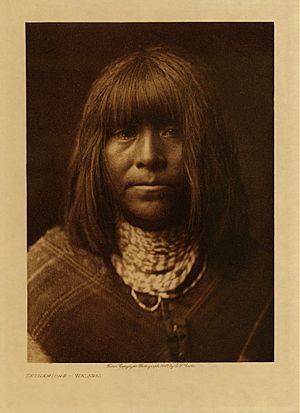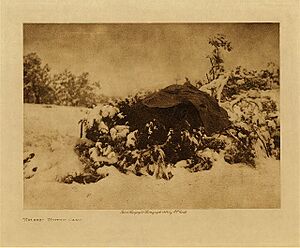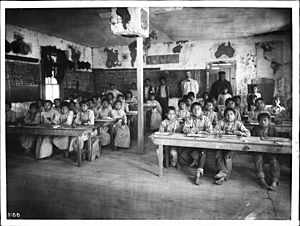Hualapai facts for kids
| Hwalbáy (Walapai) | |
|---|---|

Ta'thamiche, Hualapai 1907 photo by Edward Curtis
|
|
| Total population | |
| 2,300 enrolled members | |
| Regions with significant populations | |
| Languages | |
| Hualapai, English | |
| Religion | |
| Indigenous, Christianity | |
| Related ethnic groups | |
| Mohave, Yavapai, Havasupai |
The Hualapai (pronounced wah-lah-py) are a Native American tribe. They live in Arizona, USA. The United States government officially recognizes them as a tribe. There are about 2,300 members in the Hualapai Tribe.
Around 1,353 members live on the Hualapai Reservation. This reservation covers parts of three counties in northern Arizona: Coconino, Yavapai, and Mohave.
The name "Hualapai" means "people of the tall pines." It comes from their language. Hwa:l means "ponderosa pine," and pai means "people." Their traditional lands stretch for about 108 miles along the southern side of the Grand Canyon. This area is covered with pine trees and runs along the Colorado River. The main town on their reservation is Peach Springs. Other communities include Valentine and Grand Canyon West.
Contents
The Hualapai Language
The Hualapai language is part of the Pai branch of the Yuman–Cochimí language family. It is closely related to the language spoken by the Havasupai. It is also distantly related to the Yavapai language.
Most Hualapai people over 30 years old speak their language. Many young people also speak it. The Peach Springs School District has a great program. It teaches both Hualapai and non-Hualapai students in two languages. They also have special camps where students learn by speaking only Hualapai.
The Hualapai Reservation
The Hualapai Reservation covers about 1,142 square miles. It was created by a special order from President Chester A. Arthur. This order was made on January 4, 1883. The reservation is located in Coconino and Mohave counties.
Peach Springs is the main town and headquarters of the Hualapai Tribe.
Hualapai History and Culture
The Hualapai have rich traditions and a long history.
Important Ceremonies
The Hualapai have several important traditional ceremonies. These include the "Maturity" ceremony, which marks a young person's journey into adulthood. They also have the "Mourning" ceremony to honor those who have passed away. Today, they also celebrate a "Sobriety Festival" in June.
Beliefs About the Afterlife
The Hualapai believe that after someone dies, their spirit travels northwest. This journey leads to a beautiful land. In this land, there are many plants and good harvests. Only Hualapai spirits can see this special place.
Traditional Clothing
In the past, traditional Hualapai clothing was made from deerskin. They also wore robes made from rabbit skin.
Traditional Homes
Hualapai traditional homes were called Wikiups. These houses were shaped like cones. They were built using cedar branches and boughs.
Life on the Reservation
The Hualapai Reservation was created in 1883. It was set up on lands that some Hualapai groups already considered their home. These groups included the Yi Kwat Pa'a (Peach Springs band) and the Ha'kasa Pa'a (Pine Springs band). Other Hualapai groups lived in areas far from the current reservation land.
The Hualapai War
The Hualapai War took place from 1865 to 1870. It started because more people were traveling through the Hualapai lands. This travel was on the Fort Mojave-Prescott Toll Road. This led to more tension and conflicts between the Hualapai and European Americans.
The war began in May 1865. A Hualapai leader named Anasa was killed. In response, the Hualapai closed a major travel route. Important Hualapai leaders during this time included Wauba Yuba, Sherum, Hitchi Hitchi, and Susquatama (also known as Hualapai Charley).
Peace talks happened, but the agreement did not last long. Chief Wauba Yuba was killed during a dispute. After this, Hualapai raids on mining camps and settlers increased. The U.S. cavalry, with help from the Mohave people, fought back. They attacked Hualapai camps.
A major battle happened in January 1868. It was called the Battle of Cherum Peak. The Hualapai warriors fought bravely but lost many men. This battle weakened their ability to fight. Many Hualapai also became sick with diseases like whooping cough and dysentery.
The Hualapai began to surrender in August 1868. Chief Leve Leve led some of them. The warrior Sherum surrendered later, marking the end of the war in 1870. It is believed that about one-third of the Hualapai people died during this war. They died either from fighting or from diseases.
Hualapai Groups and Villages
The Havasupai and Hualapai people are ethnically one group. However, today they are separate because of U.S. government policies. The Hualapai had three main subtribes. These were the Middle Mountain People in the northwest, the Plateau People in the east, and the Yavapai Fighter in the south.
These subtribes were divided into seven bands. These bands were further broken down into thirteen (originally fourteen) local groups. Each local group had several extended family groups. They lived in small villages. The Havasupai were one band of the Plateau People subtribe.
Plateau People
The Ko'audva Kopaya ("The People Up Above") lived in the plateau and canyon country. This area is mostly east of the Truxton Canyon Wash. It includes parts of the Grand Canyon and the Colorado River. This area also includes the current Hualapai Reservation.
Middle Mountain People
The Witoov Mi'uka Pa'a ("Separate Mountain Range People") lived west of the Plateau People. They lived mostly north of today's city of Kingman. Their land included the Cerbat and Black Mountains.
Yavapai Fighters
The Yavapai Fighters were the largest group. They lived in the southern part of the Hualapai country. They were often the first to fight the Yavapai people, whom they called "The Enemy." This group suffered greatly during the Hualapai War. Many were lost due to fighting, destruction of their supplies, and diseases.
Education
Parts of the Hualapai Reservation in Mohave County are served by two school districts. These are the Peach Springs Unified School District and the Hackberry School District. Some Hualapai students also attend the Valentine Elementary School District.
The Peach Springs Unified School District closed its high school in 2008. Now, high school students can go to schools in the Kingman Unified School District or the Seligman Unified School District.
In Coconino County, parts of the Hualapai reservation are in an "Unorganized School District #00." This means it does not have a high school. The part of the Hualapai Reservation in Yavapai County is within the Seligman district.
Images for kids
See also
 In Spanish: Pueblo hualapai para niños
In Spanish: Pueblo hualapai para niños








